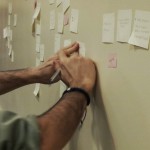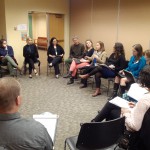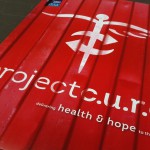Thank you to everyone who attended the NGOgraphies conference in Denver, our second biennial conference. Over 100 anthropologists and practitioners braved the snowy winter weather to participate, generating a broad spectrum of conversations and questions about research and theorization, interacting with NGOs in the field and in the complex world of publication, and improving both research and nonprofit practice.
We would like to extend a special thanks to our sponsors, the Metropolitan State University of Denver, the Association for Political and Legal Anthropology (APLA), and Northern Illinois University, our wonderful plenary speakers – Vincanne Adams, Julie Hemment, Heather Hindman, and Saida Hodžić – who provided unique insights on the conference theme, and the dedicated organizers who you can read about on our Conveners and Committee page.
Please browse our past conferences and our participation in the 2015 Denver AAA. Illinois was the site of our Interest Group’s inaugural independent conference: “The Future of NGO Studies.” Two years later, we hosted “NGOgraphies” in Denver, just before the AAA. We intend to keep this biennial tradition going with a forthcoming conference in Washington, D.C. in 2017 – again, to coincide with the AAA meetings to keep travel costs down for participants – whose theme is TBD.
Click here to view our original call for proposals
As non-governmental organizations (NGOs) take on roles and responsibilities that were traditionally in the hands of national governments, power has become increasingly denationalized and embedded in new configurations. While the scales of these mediations, service provisions, and representations have typically been categorized as local-regional-national-international, networks of NGOs now connect organizations at the grassroots directly to large-scale, transnational systems. An important aspect of the work of NGOs is to create a shared understanding of their roles and missions in relation to these resource chains, constructing the meaning of their work in relation to values and goals that circulate locally, nationally, and transnationally. Yet as Bebbington[1] notes, the conditions of poverty that development NGOs seek to address have been created through preexisting structures of colonial extraction, capitalist expansion, and consumption and production; a legacy that leaves these NGO networks unevenly dispersed, clustering in areas of perceived need and becoming sparse in regions without the infrastructure required to support them. The term “NGO-graphy”[2] calls for a critical ethnographic approach to understanding non-governmental organizations and nonprofits. It also suggests a topographic image of NGO networks that both interact with and create human landscapes.
The purpose of this second NGOs and Nonprofits conference is to engage one another in thinking broadly about the patterns of NGO practices as they point to the role of coordination within networks and the factors that direct global flows of resources and knowledge. Together, we will examine how these networks are constituted through the personal interactions, cultural practices, and shifting discourses that give them meaning. Considering the power relations that shape and create NGO-graphies also allows us to problematize the ever-present methodological question of how researchers and practitioners can and should interact with NGOs, which become sources of information about local communities, points of entry, sources of income, and fieldsites themselves. We have accepted sessions from anthropologists, related interdisciplinary scholars, and NGO practitioners on topics including but not limited to the following questions:
- How do we think beyond a “case-based” approach to conceive of broader geographies of NGO intervention?
- How do NGOs’ particular requirements in providing services create landscapes of need?
- Where do resources and knowledge originate geographically and how do they travel?
- Where are the “centers” of international NGOs and how do they interact with the “peripheries”?
- In what ways does examining how NGO work unfolds geographically contribute to shifting our perspective from viewing NGOs as entities (“nouns”) to viewing NGOs as processes (“verbs”)?
- How do “NGO cultures” draw from or feedback into the ethnic, national, and social mechanisms traditionally observed in anthropological research?
- How are the forms of knowledge valued by NGOs (technical knowledge, local knowledge, cultural knowledge, linguistic knowledge) linked to or detached from geographic contexts?
- How do indicators produced by distinct aid organizations in disparate locations create and reinforce overlapping notions of sociopolitical need, human rights, and value?
- How do NGO practitioners position themselves as experts with useful knowledge and relationships within organizations?
- What perspectives can practitioners and activists bring to academic theorizing regarding how NGO networks operate?
- How can deeper understandings of non-governmental organizational structures aid in developing effective NGO practice?
[1] Bebbington, Anthony. 2004. “NGOs and uneven development: geographies of development intervention.” Progress in Human Geography. 28(6): 725-745.
[2] Sampson, Steven and Julie Hemment. 2001. “NGO-graphy: the critical anthropology of NGOs and civil society.” Double panel, organized for the 100th Annual Meeting of the American Anthropological Association, Washington DC, November 2001.
For information regarding conference registration, facilities, scheduling, and other matters please contact ngoanthro@gmail.com.
Sponsored by Metropolitan State University of Denver, the Association for Political and Legal Anthropology (APLA), and Northern Illinois University.
Conference Coordinating Committee: Amanda Lashaw, Rebecca Mantel, Siobhan McGuirk, Rebecca Nelson, Misha Quill, Mark Schuller, Aviva Sinervo, Christian Vannier, Kim Walters





